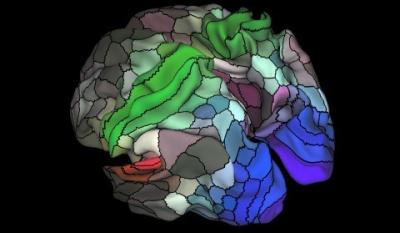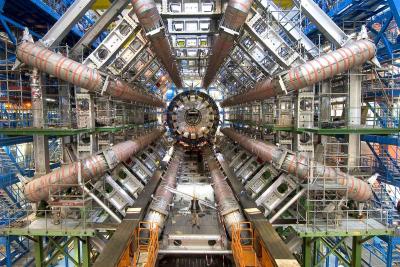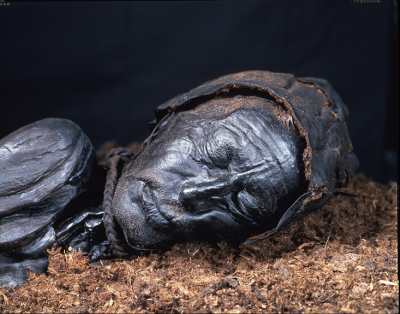Topic: SCIENCE - on December 22, 2016 at 6:02:00 PM CET
Tracking the flow of quantum information
If objects in motion are like rainwater flowing through a gutter and landing in a puddle, then quantum objects in motion are like rainwater that might end up in a bunch of puddles, all at once. Figuring out where quantum objects actually go has frustrated scientists for years. Now a Yale-led group of researchers has derived a formula for understanding where quantum objects land when they are transmitted. It’s a development that offers insight for controlling open quantum systems in a variety of situations.
... Link (0 comments) ... Comment
Topic: SCIENCE - on August 18, 2016 at 5:57:00 PM CEST
Putting a computer in your brain is no longer science fiction
Like many in Silicon Valley, technology entrepreneur Bryan Johnson sees a future in which intelligent machines can do things like drive cars on their own and anticipate our needs before we ask.
What’s uncommon is how Johnson wants to respond: find a way to supercharge the human brain so that we can keep up with the machines. From an unassuming office in Venice Beach, his science-fiction-meets-science start-up, Kernel, is building a tiny chip that can be implanted in the brain to help people suffering from neurological damage caused by strokes, Alzheimer’s or concussions. Top neuroscientists who are building the chip — they call it a neuroprosthetic — hope that in the longer term, it will be able to boost intelligence, memory and other cognitive tasks.

... Link (0 comments) ... Comment
Topic: SCIENCE - on August 13, 2016 at 12:53:00 PM CEST
Venus May Once Have Been a Garden Planet
A new model suggests a world very different from the one we know today
One of the hard facts of our solar system is that even with eight perfectly nice planets, Earth remains the only house on the block with its lights on—at least in terms of life. Mars, it’s increasingly clear, was once a warm, watery planet and had a shot at cooking up biology, but only until numerous environmental cataclysms turned it dry and cold. Now, according to environmental models run by NASA’s Goddard Institute for Space Studies (GISS) and reported in Geophysical Research Letters, Venus coulda’ been a contender too. For up to two billion years, the investigators believe, our cosmic neighbor may have been an entirely hospitable place for life.
... Link (0 comments) ... Comment
Topic: SCIENCE - on August 13, 2016 at 12:45:00 PM CEST
LHC-style supercolliders are entering a make or break phase
As the Large Hadron Collider's first sign of a superparticle melts away, physicists must contemplate their nightmare scenario.
Particle physics finds itself in testing times. This branch of science aims to describe the universe by pulling it apart into its most fundamental building blocks, or particles, and putting them back together in a way that explains how everything works. Its most robust attempt to do this, the standard model, explains the subatomic world to incredible precision – but it falls short in some big ways, lacking the parts to explain gravity and the mysterious realms of dark matter and dark energy. Theories such as supersymmetry, and on extra dimensions and new forces of nature, seek to provide the missing pieces. Almost all of these predict new particles that mighty accelerator the Large Hadron Collider at CERN near Geneva, Switzerland, is powerful enough to discover. The anticipation of finding such a particle probably explains what happened when a small bump showed up in LHC data at the end of 2015. This could have been the first sign of a particle 800 times heavier than a proton that could fit the predictions of supersymmetry. A flood of more than 500 theory papers followed in an attempt to explain it. But after adding the data taken at the LHC so far in 2016, the bump went away. The 2015 signal was just noise after all.

... Link (0 comments) ... Comment
Topic: SCIENCE - on August 7, 2016 at 5:16:00 PM CEST
Teilchenbeschleuniger LHC: Rätselhaftes Teilchen gab es nicht
Das Standardmodell der Elementarteilchen wackelt vielleicht, doch noch bricht es nicht zusammen. Eine zuvor bei 750 GeV beobachtete Diphoton-Resonanz, die auf ein neues Elementarteilchen hindeutete, hat sich in Luft aufgelöst. Auf de 38. International Conference on High Energy Physics in Chicago haben Physiker Daten präsentiert, die viele Physiker enttäuschen dürften. Die vermeintlich bei 750 GeV gemessene Resonanz – die auf ein neues Teilchen und Physik jenseits des Standardmodells hinweisen sollte – ist in neuen Daten nahezu komplett verschwunden. Die vorläufigen Daten hatten für Aufruhr in der Welt der Teilchenphysiker gesorgt und mehr als 500 wissenschaftliche Arbeiten nach sich gezogen, wie der New Scientist gezählt hat. Wissenschaftler hatten "endlich" neue Physik gewittert – vom Vetter des Higgs-Teilchens über supersymmetrische Partner des hypothetischen Goldstino bis zur einfachen Zerfallskaskade mit Photonenpaaren.
... Link (0 comments) ... Comment
Topic: SCIENCE - on August 7, 2016 at 5:10:00 PM CEST
New particle hopes fade as LHC data 'bump' disappears
Hopes for the imminent discovery of a particle that might fundamentally change our understanding of the Universe have been put on hold. Results from the Large Hadron Collider show that a "bump" in the machine's data, previously rumoured to represent a new particle, has gone away. The discovery of new particles, which could trigger a paradigm shift in physics, may still be years away. All the latest LHC results are being discussed at a conference in Chicago. David Charlton of Birmingham University, leader of the Atlas experiment at the LHC, told BBC News that everyone working on the project was disappointed. "There was a lot of excitement when we started to collect data. But in the [latest results] we see no sign of a bump, there's nothing. "It is a pity because it would have been a really fantastic thing if there had been a new particle."
... Link (0 comments) ... Comment
Topic: SCIENCE - on August 2, 2016 at 3:37:00 PM CEST
MIT made a movie screen that brings 3D to all seats – without the glasses
Seeing 3D movies in theaters isn’t my preferred choice for a bunch of reasons, but the glasses definitely rank among its most annoying features. The cheap plastic things always have to ride atop my existing, actual vision glasses, for one, and they also always seem to be scratched or otherwise marked up. Which is why news that MIT has developed a glasses-less 3D display tech suitable for use in movie theater settings – even if it’s only a prototype – is so welcome.
... Link (0 comments) ... Comment
Topic: SCIENCE - on July 28, 2016 at 4:43:00 PM CEST
Found: Mysterious Bright Purple Blob, Floating in the Deep Sea
This is one of the best sounds you can hear when eavesdropping on scientists: “Oh, what is that?” The research team of the E/V Nautilus, a vessel of the Ocean Exploration Trust, was using their remotely operated underwater vehicle to check out the deep sea around the Channel Islands when they saw something they never had before: a small, glowing purple blob.

... Link (0 comments) ... Comment
Topic: SCIENCE - on July 16, 2016 at 6:10:00 PM CEST
The Curious Case of the Bog Bodies
One Saturday in the spring of 1950, brothers Viggo and Emil Højgaard from the small village of Tollund, in Denmark, were cutting peat in a local bog when they uncovered a dead man. He looked as though he had only just passed away. His eyelashes, chin stubble, and the wrinkles in his skin were visible; his leather cap was intact. Suspecting murder, the brothers called the police in nearby Silkeborg, but the body wasn’t what it seemed. Cracking the case required a special breed of forensic analysis. Famed Danish archaeologist Peter V. Glob, from the University of Aarhus, arranged for the body, along with its bed of peat, to be excavated and transferred to the Silkeborg Museum in a giant wooden box. An examination of the contents of the dead man’s stomach suggested—and radiocarbon dating later confirmed—that he had lived during the third century B.C., in the pre-Roman Iron Age. For more than 2,000 years, Tollund Man, as the corpse became known, had lain at the bottom of the bog, nearly untouched by time, as all of recorded history marched forward over his head.

... Link (0 comments) ... Comment
Topic: SCIENCE - on July 15, 2016 at 10:56:00 AM CEST
Biggest cosmic map will throw light on ‘dark energy’
An international team of astronomers has created the largest ever three-dimensional map of distant galaxies in a bid to help them understand one of the most mysterious forces in the universe. Scientists including a team led by Dr Florian Beutler at the University of Portsmouth’s Institute of Cosmology and Gravitation have spent a decade collecting measurements of 1.2 million galaxies as part of the Sloan Digital Sky Survey III (SDSS-III). This will allow them to make the most precise measurements to date of ‘dark energy’ – the force that is driving the accelerated expansion of the universe.
... Link (0 comments) ... Comment
Topic: SCIENCE - on July 11, 2016 at 1:09:00 PM CEST
A Telescope the Size of Earth Just Captured a Supermassive Black Hole Eating a Star
Astronomers just got their most precise look to-date at a supermassive black hole gobbling up a star. The research could help us figure out what exactly happens when stars get eaten by black holes — and why those black holes sometimes shoot out jets of particles at nearly the speed of light.
... Link (0 comments) ... Comment
Topic: SCIENCE - on July 5, 2016 at 4:06:00 PM CEST
Neutrinos hint at why antimatter didn’t blow up the universe
It could all have been so different. When matter first formed in the universe, our current theories suggest that it should have been accompanied by an equal amount of antimatter – a conclusion we know must be wrong, because we wouldn’t be here if it were true. Now the latest results from a pair of experiments designed to study the behaviour of neutrinos – particles that barely interact with the rest of the universe – could mean we’re starting to understand why. Neutrinos and their antimatter counterparts, antineutrinos, each come in three types, or flavours: electron, muon and tau. Several experiments have found that neutrinos can spontaneously switch between these flavours, a phenomenon called oscillating.

... Link (0 comments) ... Comment










